I’m a pushover for powerful art. Are you?
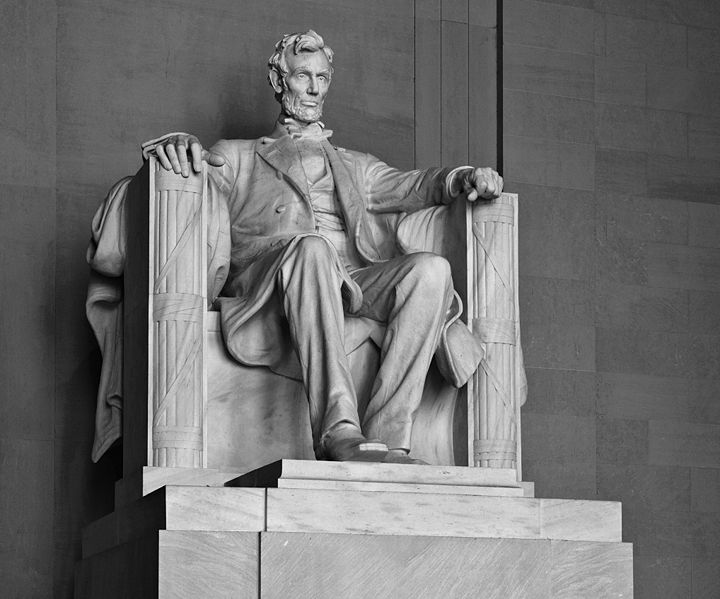
Daniel Chester French. The Lincoln Memorial
And by “powerful” I often mean Big. Big in size, Big in ideas, Big in meaning, Big in its very conception.
Bigness in this awful general sense becomes, for me, tied to big strong emotional reactions. And yes, my bs reactions are often due to context — I first saw the Lincoln Memorial near dusk, after weeping my way through the Vietnam Memorial. I was alone, exhausted, isolated in “our” nation’s capital. I was overwhelmed.
I like my architecture to overwhelm me. I’m enthralled by the Lincoln Memorial. I love the abstract expressionists because they worked on outsized canvases.
Louise Nevelson, Transparent Horizon
Maybe I just have bad eyes. Or maybe I haven’t the patience for tiny constructions. But I think I like big splashy coffee table books of Georgia O’Keefe and Emily Carr a bit better than the original paintings — and that’s an admission I’m not sure I should have made.
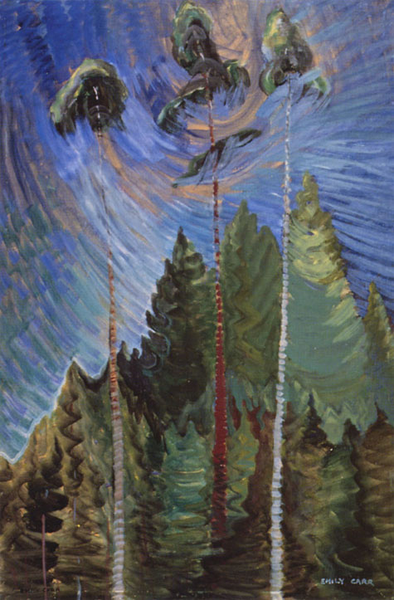 Emily Carr, Odds and Ends
Emily Carr, Odds and Ends
Bigness is a matter of context, of course. A large splashy photo in a coffee-table book looks bigger than an 8 x 10 photograph although they might be the same size. A 10 by 10 foot painting in a warehouse gallery with 50 feet ceilings can just look pathetic. So it’s as much about scale as size.
And of course, Big is not always Powerful. Big is sometimes just stupid. Or kitsch.
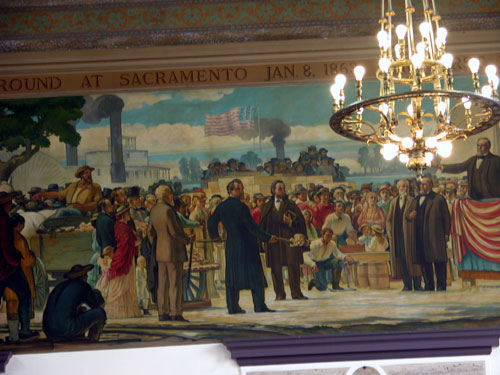
So by powerful, I can be meaning….
It fills my entire vision, including my inner eye ( Joseph Cornell’s boxes can sometimes capture me)
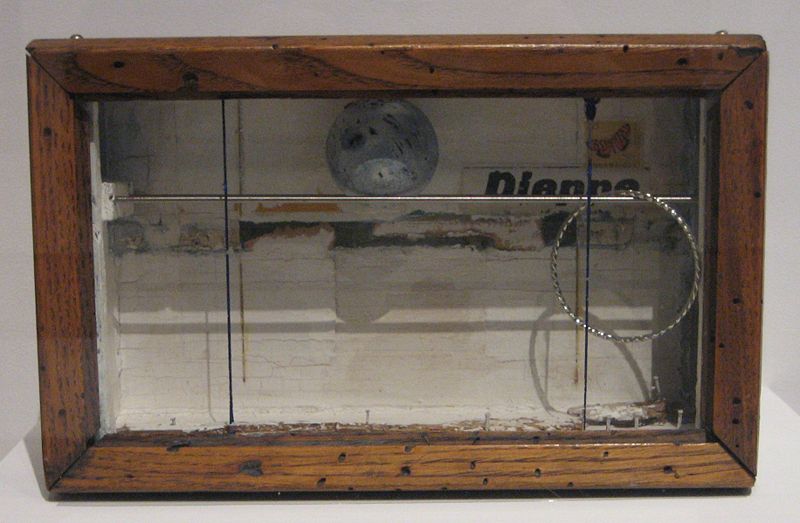 Joseph Cornell, Untitled, c. 1958
Joseph Cornell, Untitled, c. 1958
By powerful, I could mean — it reads as moving through time (harder to explain but it has something to do with being worked over time)
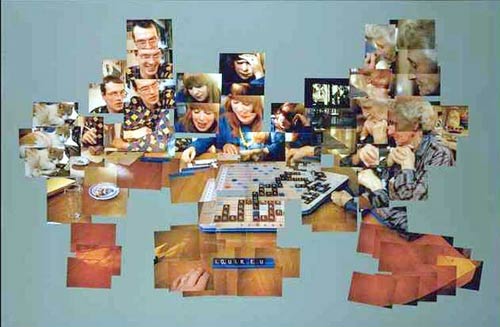 David Hockney, Scrabble Game
David Hockney, Scrabble Game
By powerful, I also might mean –it needn’t surprise me, but if it doesn’t surprise, then it should mystify:
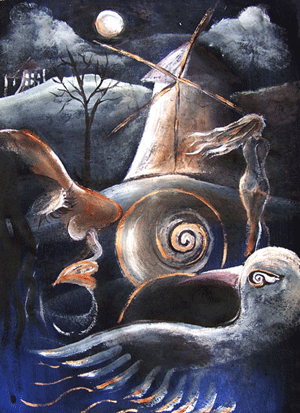 Angela Ferreira, Spiritual
Angela Ferreira, Spiritual
and if it doesn’t mystify, then it has to be Big.
Your favorite Big painting here:

Oh dear, I’m just reading Jay’s misplaced comments (at the end of Sunil’s post) and I’m thinking that I may have just stepped in it. Innuendos will abound.
However, I guess Jeff Koons works Big, so maybe I can scrape my shoes and slide away. But if you get too bumptious, Jay, I’ll root for the other team this evening.
Wow, I hadn’t seen that Ferreira painting before. Beautiful. But not necessarily big, on my laptop monitor at least. Great picture anyway. I’ve been working big lately, although for me that only means 50 x 70 cm or so.
Karl,
I have a nice big monitor, but am aware that posting the photos at the size I love to look at makes other people with smaller monitors a bit crazy. So I dummied down the already somewhat small photo sizes. But I love, love, love them to fill my screen.
I need to convert centimeters to inches so I know what you think of as “big.”
June:
“Innuendo” as a term, might best be reserved for the porno post. And please feel free to root for the BoSox if that will help them lose – those bean eaters.
Anselm Kiefer (yes, again) gets my nod what with his deep perspectives and things to see all the way in. Pollock. Tiny Elvis.
June,
I have a similar relationship to the Lincoln memorial. When in Washington, I always go to see it, read the text, have a cry. Strangely enough, I never really thought of it as art, though obviously it is.
But I have no general bias towards big. I like it in places, but I also like small. A favorite photographer, Michael Kenna, prints at less than 8″x8″ (20cmx20cm). His reasoning:
Jay,
You and Tree convinced me to look at Anselm Kiefer and now I must must must see more. Where have I been all this time?
Steve,
Small means you have to be intent and look intensely — you have to examine up close and get your nose a bit blackened. You can ignore small or totally fall into it — your choice.
Large means you are encompassed, willy-nilly. You can’t escape the experience.
These are viewer’s perceptions, of course. The artist’s perception is probably quite different. I’d have to think on that.
June,
I have the opposite reaction.
Looking at Lincoln, I feel like scoffing at this display of male culture. Coming from Europe, I am so used to laughing at monuments of kings and statesmen.
Oversized pieces of ‘real art’ have to really appeal to whatever is my brand of art appreciation. Otherwise, I find them silly, ostentatious.
Maybe, Birgit, it’s the difference in our background. I may have been exposed to one Civil War monument in the middle of the “5-way-lights” (think town of 4000 population, 15 miles from my home) but other than that, nothing where I lived was big except the mountains and the river and the fields. Even the more middle class houses were small. And the county courthouse had been modernized so there was no grand entrance or columns of marble (no columns at all) to play with my child’s mind. So as an adult, I can see these newly. I even love the tangle of interstate supports and concrete that I walk under every day. I don’t love the interstate, nor the cars that drive on it, but there’s something wondrously elegant –and obviously Big — about those curving concrete structures.
But there certainly are a lot of silly and ostentatious big works of art (as, now that I think of it, silly if not ostentatious little pieces of art — art does not preclude silliness)
But Birgit, can you think of a Big Piece of Art that you like?
June,
I love large structures that are functional such as the ‘tangle of interstate supports’ and bridges, airplanes and some buildings.
Of the large paintings that I saw in NYC, the ones that immediately come to mind are a Rousseau Jungle scene at the MOMA and a somewhat abstract deKooning at a special exhibition at the MET. It showed a mountainside that gave me the feeling as if there was a lot of downwards movement.
Big. Powerful. Yes, all in the eyes and mind of the beholder in some respects. I’ve had times when I’ve been overwhelmed by a blade of grass.
Studying from books, scale becomes inconsequential. You can lose a lot this way but gain, too. Preconceived notions can go a long way towards making a piece feel big and powerful, regardless of the size. To Birgit, the Lincoln Memorial is unimpressive. But to others, maybe someone who marched for Civil Rights in the 60s, it can be immense.
But I think that sculptures and paintings that are self consciously created to “make an impact” reveal themselves as such and therefore lose their punch.
But, when all is said and done, I can quiet my mind and it’s criticisms and be in love with the Jefferson Memorial in the evening. And I long for the day I can wander through a museum like the Louvre and come across giant 19th century historical paintings that take my breath away.
Jay, as a born-and-raised bean eater, I feel I MUST disregard your hurtful remark about the Red Sox in order to maintain our friendly relations. When the Indians lose the Series, I will of course remain magnanimous towards you and not humiliate you any further. (heehee!)
Tree,
Your comments about “big” resonate with me.
However, I do think it’s cruel of you to twit jay in that way. After last night’s Sox/Cleveland game, surely lady, you could dredge up a bit of mercy.
Alas, it appears the Sox fans now are just ordinary winners, no longer able to empathize wholly with the sorely tried in this world (add snort here)
June, it’s a well known fact that cruelty can arise from ignorance. Having been out most of the evening, I didn’t know that the Indians were so soundly and wonderfully beaten…I mean, I didn’t know the score. My apologies to Jay. And my sympathy.
But hey, it ain’t over ’til it’s over.
You’re right though, we Sox fans have acquired quite a bit of hubris. But nothing bad comes out of hubris, right?
Hey Tree, I was definitely teasing (didn’t you hear that snort?) How could you not have heard the yells of sweet moments, all over the east coast?
Out here on the west coast, we can’t take those eastern games seriously, although half the household (the inhabitants) was rooting for Cleveland and the other half (visitors) for the Sox. But the cheers and sneers were pretty half-hearted. Today, however, the Oregon Ducks (Ducks!!!) seem to be doing quite well and there’s nothing half-hearted about the cheers you hear around here.
Birgit:
I doubt that Lincoln would have approved of his memorial. And Mt. Rushmore would have sent him over the edge; he didn’t have that kind of self image. But I must say that few have been endowed with such a sculptural visage.
What I like is the Washington Monument. It’s an obelisk, but without the epigraphy and decoration. As such, it registers for me as one of the earliest and most successful examples of a minimalist aesthetic.
It’s like the harder it is to wrap one’s mind around something, the bigger the sculptural attempt to so encompass becomes. For the Russians, the sheer scope of their victory in WWII led to the production of the world’s biggest free-standing sculpture. Compare that to Gettysburg where the palpable windrows of death still hang over the battlefield. One encounters the place one location, soldier and unit at a time. There is little constructed immensity there, but rather memorials such as one might find over at the Lakeview Cemetery.
June makes an important point in that sheer scale makes a difference: there’s a certain quality in quantity.
I guess I wasn’t done.
Thinking about the bare-faced Washington Monument, what narrative would one carve upon it? I ask this assuming that it was left bare as Washington’s new-born United States was a tale to be told. Are we maybe talking some version of Trajan’s Column here,or perhaps an Egyptian style replete with cartouches? I would advocate a less intrusive approach. It might involve a supply of spray cans, courtesy of the Park Service. Taggers, representing various ethnic, religious and other interests, would rappel from the upper windows, vying to emblazon their symbols and messages in the choicest locations. These taggers would be chosen by members of Congress as spokespersons for their respective interests
and launched out the windows by lottery. On a regular basis, the surface of the monument would be set alight in a controlled burn as an act of renewal,or hosed down. I can hardly wait to see the societal dynamics that such a scenario would – and I anticipate – will unleash.
Hi June, I was just teasing, too :-)
Tree — Whew! I wasn’t sure. Sometimes I read wrong-way to — or make that “Often”. Anyway, whew!
Jay, I never think of Mt Rushmore as art — more like propaganda or jingoism. It might be the juxtaposition of Lincoln with the Vietnam Memorial’s ground slash that sets me to experiencing both as reactions to tragedies that can never be set right. The Civil War killed more people, mostly but not all, soldiers than any other war in our history. That’s what I see in Lincoln’s craggy countenance. And the Vietnam War killed thousands, or even hundreds of thousands, as an act of sheer hubris. (I’m reading Halberstam’s Best and Brightest and my notions are reinforced by his research).
And re-creating the Washington Monument — hmm, have to think about that. I’ve always seen it as sheer macho, so I guess I should look again. I always see the water as the art.
I do love the idea of a people’s art — participation that can be undone. It might make art a more palatable aspect of American’s lives — but probably not, now that I think about it.
When I was a little girl, I asked my mother what was up, so to speak, with the Washington Monument. She turned to me and whispered forcefully, “It’s a giant penis!” No truer words were spoken, in my opinion.
If one was into conspiracy theories, one could have a field day with all that “stuff” in Washington.
June, would you consider the AIDS quilt to be “people’s art?”